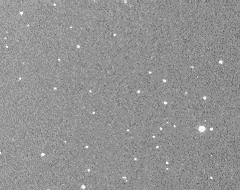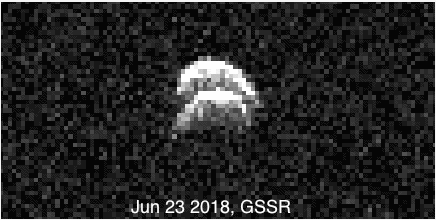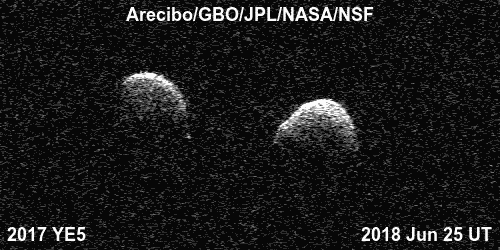Jason Davis • Jul 24, 2018
Planetary Society asteroid hunters help find rare type of double asteroid
A global team of astronomers has found a rare type of asteroid, where two equal-mass objects circle each other in a never-ending dance as they hurtle through the solar system.
Many asteroids have moons, or even multiple moons. But this asteroid, known as 2017 YE5, is just the fourth "equal mass" double near-Earth asteroid ever detected, in which both objects have roughly the same mass and size. Each is about 900 meters wide.
The discovery was the combined result from three giant radio telescopes and observations by advanced amateur astronomers at observatories around the world. Two of those observatories have received past or current funding from the Planetary Society’s Shoemaker NEO Grant program, which funds observers who track and characterize near-Earth asteroids.
The story of asteroid 2017 YE5 starts on Dec. 21, 2017, when French astronomer Claudine Rinner discovered the object using the Morocco Oukaïmeden Sky Survey, or MOSS. MOSS was a 2018 Planetary Society Shoemaker grant winner. Here’s an animation of the asteroid from MOSS observations:

Not much else was known about 2017 YE5 until June, when it made it is closest approach to Earth, coming within 6 million kilometers—16 times the distance between the Earth and Moon. Three of the world’s largest radio observatories teamed up to take a closer look: NASA's Goldstone Deep Space Communications Complex in California, Arecibo Observatory in Puerto Rico, and Green Bank Observatory in West Virginia. By zapping an asteroid with radar and reading the reflected signal, scientists can make images of asteroids that optical telescopes only see as points of light. (For this observation, Arecibo transmitted and Green Bank received the reflection; Goldstone both transmitted and received.)
This animation by Goldstone on June 23 showed 2017 YE5 might be two objects, but it wasn’t conclusive whether the two objects were connected or separate:

Around the same time, Brian Warner at the Center for Solar System Studies (CS3) in Rancho Cucamonga, California, was observing 2017 YE5. CS3 has won four Planetary Society Shoemaker grants over the years, with the most recent coming in 2018. Warner told me a researcher at Arecibo Observatory sent out a message to the observing community seeking light curves from optical telescopes, because it appeared 2017 YE5 might be two objects orbiting each other every 12 to 24 hours. Warner observed the asteroid on four different nights, and his data fit with that hypothesis.
By then, radar observations began showing a much clearer separation between the two objects. Here’s an animation from Arecibo and Green Bank on June 25:

A NASA press release said the rotation period is now estimated to be between 20 and 24 hours. The two objects that make up 2017 YE5 are as dark as charcoal, but they reflect different amounts of light, which is a phenomenon not usually seen in binary asteroids. This means they may have different densities or surface compositions.
Warner told me the story of 2017 YE5 is a good example of the importance of open communication in the observing community. There’s often just a short window to observe dim, near-Earth asteroids, so astronomers must work together to gather as much data as possible before the object slips back into space.
2017 YE5 is already on its way back out to the asteroid belt. It will pass Mars on July 30, and won’t come close to Earth again until 2037, at a much greater distance of 0.2 AU.
Let’s Go Beyond The Horizon
Every success in space exploration is the result of the community of space enthusiasts, like you, who believe it is important. You can help usher in the next great era of space exploration with your gift today.
Donate Today

 Explore Worlds
Explore Worlds Find Life
Find Life Defend Earth
Defend Earth

